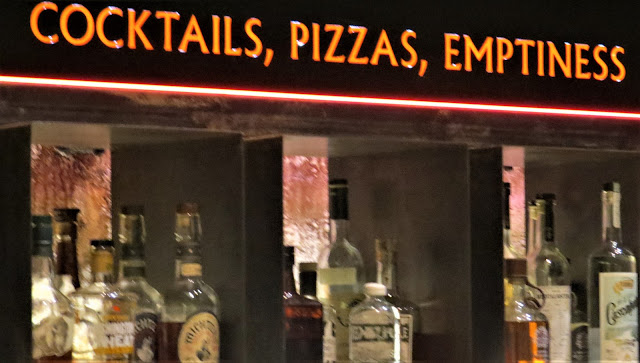 |
| The Museum of Old and New Art may have more opportunities for cocktails and other alcohol than any other museum in the world, all garnished with a bit of humor, |
We flew Air New Zealand on Sunday, Feb. 5, 2023, from Auckland to Hobart and stayed stayed three nights on the harbor at MACq 01. After seven days driving around the island, we returned to Hobart and this time stayed at the MACq 01's sibling hotel, just across the street, called the Henry Jones Art Hotel, which is in a converted jam factory. The MACq 01 is a large new building that takes up an entire quay and has several restaurants. My favorite spot is the Evolve Spirits Bar, where the drinks list includes 38 Tasmanian-made gins (all with tasting notes) as well a huge range of other spirits, beers and wines. Gin and tonic was my go-to cocktail on this trip and, thanks to the variety of gins, no two tasted alike. The Art Hotel also has a notable bar that often has live music.
The privately funded Museum of Old and New Art (usually referred to as MONA), is the pet project of owner David Walsh, described as a wealthy gambler, and houses his collection of ancient, modern and contemporary art. Sex and death reappear throughout the museum as central themes. Walsh has called the museum a "subversive adult Disneyland" (at least two works explicitly depict beastiality).
The current museum is a successor to his Moorilla Museum of Antiquities, which opened in 2001 and closed in 2006. After a $75 million upgrade, the museum opened under its current name in 2011 and appears to undergo frequent changes, such as the recent addition of walk-through tunnels bored into the rock of the waterside site. Visitors download an app that allows their smartphones to display information and often Walsh's own comments about works throughout the museum. There are no identifying labels on anything anywhere. Cafes and bars make it easy for morning visits to become all-day visits. There is certainly enough to see. We began our visit by taking the museum's shuttle bus from the harbor (it's about a 20-minute ride) and we ended it by taking the museum's ferry, which is more like a boozy party boat, back to the harbor.
Another place outside town is the Tasmanian Devil Unzoo, which is on the way to Port Arthur, the site of the brutal prison for new arrivals from Britain's jails back during Britain's invasion and takeover of Australia. We skipped Port Arthur but the Unzoo is worth the 90-minite drive. Other than the captive Tasmanian devils, the Unzoo is more like a wildlife sanctuary, with wallabys, forest kangaroos (a bit smaller than those one thinks of on the Australian mainland), Cape Barron geese, parrots and about 10 percent of the bird species that can be found in Australia. Visitors have the opportunity to handfeed some of the suspiciously tame wildlife and see the usually nocturnal devil up close. Devils in the wild across Tasmania are dying of a viral facial cancer that is 100 percent fatal. It spreads through bites, which are part of normal devil interaction. It's hoped that the wild population on the Port Arthur peninisula is isolated enough that the cancer won't reach there. Otherwise, captive animals may be the species' best hope for survival. One noticeable effect of the devil epidemic is that there are no scavengers to devour roadkill. A devil can eat 40 percent of its weight in a half hour, and with them disappearing, there's no one to eat all the dead wallabys and wombats and other animals struck by cars.
Here are photos from our time in Hobart and areas nearby:
 |
| Light-hearted signs such as this can be seen around Hobart. |
 |
| Airplane rides are offered at the harbor. |
.jpg) |
| The horizontal building at upper left is the MACq 01 hotel. |
 |
| Hobart was getting ready for a tallships festival when we left town to explore elsewhere in Tasmania. |
 |
| "bit.fall" by Jules Popp at MONA. Drops of water are released so precisely that they form letters and spell words during the first few feet of their fall. |
.JPG) |
| Beanbag chairs and live music on the lawn at MONA. Cafes and food counters open onto the lawn. |
.jpg) |
| This couch was one of Jane's favorite works at MONA. It purrs when you stroke it. Visitors are invited to sit on it. Above is a screensave from the museum's app. |
.jpg) |
| Another screensave. A real-life Porsche was sacrificed to make this commentary on consumer excess. |
 |
| A Tasmanian devil at the Unzoo. Its ears appear red when light strikes from behind and highlights blood vessels. |
 |
| The same devil devouring a wallaby leg. |
 |
| Unzoo visitors can hand feed Cape Bannon geese, which, we were told, are unrelated to other kinds of geese. |
 |
| Visitors are allowed to wander among forest kangaroos at the Unzoo. There are also wallabys there, but they weren't around when we were. |
.jpg)

No comments:
Post a Comment